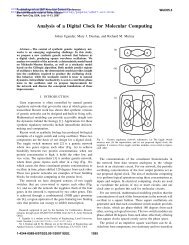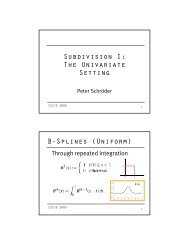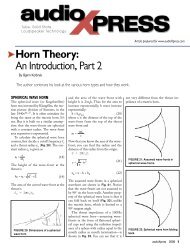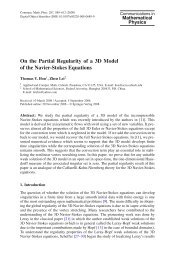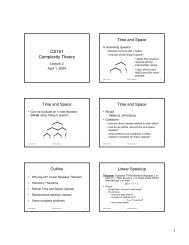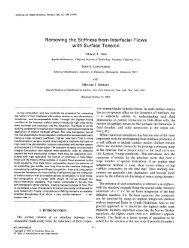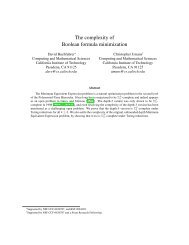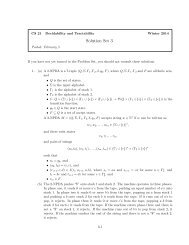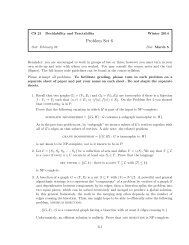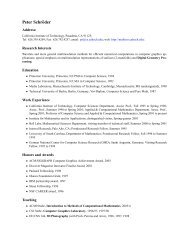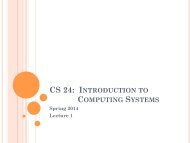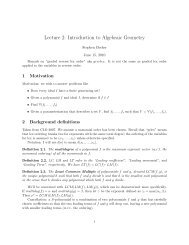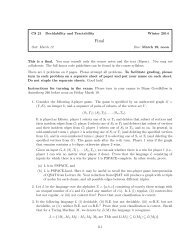From Steiner formulas for cones to concentration of intrinsic volumes
From Steiner formulas for cones to concentration of intrinsic volumes
From Steiner formulas for cones to concentration of intrinsic volumes
Create successful ePaper yourself
Turn your PDF publications into a flip-book with our unique Google optimized e-Paper software.
STEINER FORMULAS FOR CONES AND INTRINSIC VOLUMES 218.3. Extension <strong>to</strong> general convex <strong>cones</strong>. Next, let us extend the master <strong>Steiner</strong> <strong>for</strong>mula, Lemma 8.1 frompolyhedral <strong>cones</strong> <strong>to</strong> closed convex <strong>cones</strong>. Our strategy is <strong>to</strong> approximate a convex cone with a sequence apolyhedral <strong>cones</strong>, apply Lemma 8.1 <strong>to</strong> each member <strong>of</strong> the sequence, and use continuity <strong>to</strong> take the limit.Lemma 8.4 (Extension <strong>to</strong> closed convex <strong>cones</strong>). Let f : R 2 + → R be a bounded continuous function, and letC ∈ C d be a closed convex cone. Then the master <strong>Steiner</strong> <strong>for</strong>mula (8.1) still holds.Pro<strong>of</strong>. Fact 7.4 ensures that polyhedral <strong>cones</strong> <strong>for</strong>m a dense subset <strong>of</strong> C d , so there is a sequence (C i ) i∈N <strong>of</strong>polyhedral <strong>cones</strong> in C d <strong>for</strong> which C i → C as i → ∞. We also have the limit C ◦ i → C ◦ . Lemma 8.1 implies thatTaking the limit as i → ∞, we reachE [ f ( ‖Π Ci (g )‖ 2 , ‖Π C ◦ (g )] d∑)‖2 = ϕi f (L k ) · v k (C i ) <strong>for</strong> i ∈ N.k=0E [ f ( ‖Π C (g )‖ 2 , ‖Π C ◦(g )‖ 2 )] =d∑ϕ f (L k ) · v k (C).To justify the limit on the left-hand side, we invoke the dominated convergence theorem. This act is legalbecause f is bounded and continuous, the squared Euclidean norm is continuous, and the metric projec<strong>to</strong>r iscontinuous. The limit on the right-hand side follows from the continuity <strong>of</strong> <strong>intrinsic</strong> <strong>volumes</strong> expressed inProposition 8.2.□8.4. Extension <strong>to</strong> integrable functions. We are now prepared <strong>to</strong> complete the pro<strong>of</strong> <strong>of</strong> the master <strong>Steiner</strong><strong>for</strong>mula that we announced in Section 3.1. All that remains is <strong>to</strong> expand the class <strong>of</strong> functions that we canconsider. The following lemma contains the outstanding claims <strong>of</strong> Theorem 3.1.Lemma 8.5 (Extension <strong>to</strong> integrable functions). Let f : R 2 + → R be a Borel measurable function, and let C ∈ C dbe a closed convex cone. Then the master <strong>Steiner</strong> <strong>for</strong>mula (8.1) still holds, provided that each expectation is finite.Pro<strong>of</strong>. Let us reinterpret Lemma 8.4 as a statement about measures. The Banach space C 0 (R 2 + ) consists<strong>of</strong> bounded and continuous real-valued functions on R 2 + that tend <strong>to</strong> zero at infinity. Consider a functionh ∈ C 0 (R 2 + ), and observe that the left-hand side <strong>of</strong> (8.1) can be written asϕ h (C) = E [ h ( ‖Π C (g )‖ 2 , ‖Π C ◦(g )‖ 2 )] ∫= h(s, t)dµ(s, t)where the measure µ is defined <strong>for</strong> each Borel set A ⊂ R 2 + by the rulek=0µ(A) := P {( ‖Π C (g )‖ 2 , ‖Π C ◦(g )‖ 2 ) ∈ A } .Similarly, the right-hand side <strong>of</strong> (8.1) can be written asd∑d∑(∫ϕ f (L k ) · v k (C) =k=0where the measure µ k is defined viak=0)h(s, t)dµ k (s, t) · v k (C)µ k (A) := P {( ‖Π Lk (g )‖ 2 , ‖Π Lk◦(g )‖ 2 ) ∈ A } .As a consequence, Lemma 8.4 demonstrates that∫ ∫ ( )d∑h dµ = h d v k (C)µ kk=0<strong>for</strong> h ∈ C 0 (R 2 + ). (8.7)We claim that (8.7) guarantees the equality <strong>of</strong> measuresd∑µ = v k (C) · µ k . (8.8)k=0Because the measures are equal, it holds <strong>for</strong> each nonnegative Borel measurable function f + : R 2 + → R + that∫d∑(∫ )f + dµ = f + dµ k · v k (C).k=0We can replace f + with any Borel measurable function f : R 2 + → R, provided that all the integrals remain finite.Reinterpreted, this observation yields the conclusion.



